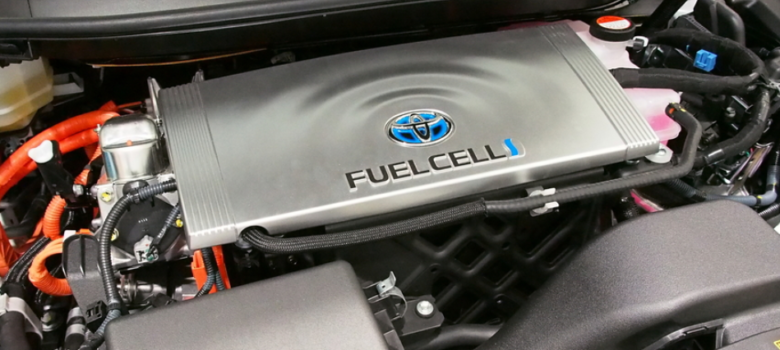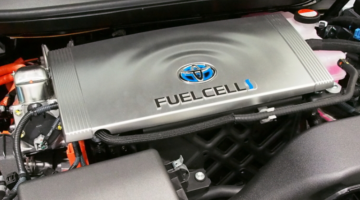
Wikipedia helpfully informs us that “A fuel cell is an electrochemical cell that converts the chemical energy from a fuel into electricity through an electrochemical reaction of hydrogen fuel with oxygen or another oxidising agent”. Now I don’t know about you, but if I wasn’t in this industry then I would have absolutely no idea what that actually means. We therefore thought it might be a good idea to introduce fuel cells to those of us without a PhD in chemistry.
What Can We Use Fuel Cells For?
Fuel cells have been used for years to produce electrical energy on spacecrafts owing to their compact, high efficiency, lightweight design and lack of moving parts. In what can only be described as Very Cool Space Science, the water produced by the reaction of the fuel cells can even be used by the astronauts as drinking water. That’s how clean this tech is.
On a slightly more terrestrial front, manufacturers are in development of fuel cells for use in cars and other vehicles. While lots of them are doing demonstrations and getting everyone excited, as of 2015 two fuel cell vehicles have been introduced for commercial lease and sale in limited quantities: the Toyota Mirai and the Hyundai ix35 FCEV. Unlike other electric cars, fuel cell vehicles have a longer driving range between refuels and can be refueled in under 5 minutes. Buses too are getting the makeover, with the Fuel Cell Bus Club providing a global cooperative effort to trial fuel cell buses.
There’s certainly come skepticism about the economic viability of mainstream fuel cell cars. Elon Musk, he of Tesla fame and the giant battery in Australia, has voiced serious concerns over the inefficiency of producing, transporting and storing hydrogen and the flammability of the gas.

How do Fuel Cells Work?
A fuel cell is the name given to a device that generates electricity by a chemical reaction. They are powered by hydrogen and oxygen, requiring both to work. It’s all about converting the chemical energy in the hydrogen into electricity
To qualify as a fuel cell it must have two electrodes called the anode and the cathode, and it’s between these two electrodes that the reaction takes place and energy is generated. The other thing you need is an electrolyte, which you may vaguely know as something you lose when you’re hungover or unwell (I’ll give you a benefit of the doubt and assume that it would only ever be the later). In fact an electrolyte is a substance that produces an electrically conducting solution when dissolved; in a fuel cell the electrolyte is there to carry electrically charged particles from one electrode to the other. It also provides the name for this type of fuel cell – PEM (Proton Exchange Membrane). What’s so special about it is its ability to allows protons to pass through virtually unimpeded, while electrons are blocked. This means that when it’s hit by hydrogen atoms, it splits them into protons and electrons (stay with me, try not to have traumatic school science lesson flashbacks). The protons are directed towards the cathode, but the electrons are forced to take a much longer route – they travel an external circuit, generating the power we need to boil our kettles or watch Strictly Come Dancing repeats on UKTV Gold. When they meet back up with the protons and combine the result ain’t nuthin’ but good old H2O.
You might wondering what makes fuel cells so different from batteries. A battery converts the finite energy stored inside by the chemicals contained, while a fuel cell requires continuous sources of both hydrogen and oxygen to maintain the chemical reaction. Fuel cells can, therefore, produce electricity continuously as long as fuel and oxygen supplies are both constant.
Why are People so Excited About Fuel Cells?
Fuel cells have a lot of inherent benefits over other forms of energy generation, not least by producing electricity without burning up the hydrogen (or other fuel) that powers them. Of course any technology that can generate energy with emissions amounting to only a water and a little heat is going to be alright by us!
Unlike internal combustion engines, fuel cells have no moving parts, resulting in a simpler and more reliable energy source that is relatively compact for the amount of energy produced. There are also some more involved sciencey benefits – many engine types fall victim to something known as as the “thermal bottleneck”, a direct consequence of the 2nd law of thermodynamics. By converting chemical energy to electrical energy directly this bottleneck is avoided, significantly improving efficiency.
The Earth has vast amounts of water, which can be decomposed – using electricity – to produce hydrogen (and oxygen). This process is called electrolyzing and many of the larger scale fuel cell generation projects also maintain the facilities for it on-site.
Where are we at with Fuel Cell Technology?
In the UK we are still having arguments about gas vs. nuclear fission as being the base energy load for the next few decades. We are slowly bringing renewable technologies into the mix but at quite a slow rate – only 10% of the total energy supplied at the moment is from renewable resources. The truth is that we’re still many years away from making a lot of these methods pay off and seemingly even further away from increasing the scale of fuel cell technology to be even seen as a viable base load method of energy production.
We are making huge advances though! As recently as last week Science reported on an inexpensive, powerful new fuel cell based on midrange temperatures, that could boost the prospects for plentiful green energy. Most fuel cells run at temperatures too hot or too cool to make at a reasonable price. Low running temperatures make essential chemical reactions sluggish, requiring the use of expensive metal catalysts to speed them up, but high operating temperatures require that they be built from expensive metal alloys that can handle the soaring heat. Recent developments suggest that we may be getting closer to a Goldilocks operating temperature that would greatly improve the potential of fuel cells moving forward.
Think we missed something? Do you have a different opinion?
Comment below to get your voice heard…












No Comments yet! Be the first one.